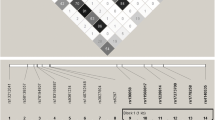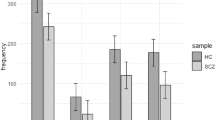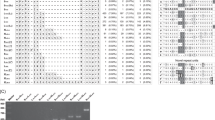Abstract
There is some evidence suggesting that a polymorphism of variable number of tandem repeats (VNTR) in the second intron of the serotonin transporter (5-HTT) gene and another variation which lies 1.2 kb upstream of the promoter of the gene (5-HTTLPR) are associated with affective disorders. However, conflicting results have also been reported. We examined an allelic association of these two polymorphisms in a Japanese sample of 191 patients with affective disorders (142 bipolar and 49 unipolar) and 212 controls. Substantial differences in the number and frequency of alleles between Caucasians and Japanese were observed for both polymorphisms. A significant association between the VNTR polymorphism and bipolar disorder (genotypic association: odds ratio 2.2, 95% CI 1.2–4.0; allelic association: odds ratio 1.7, 95% CI 1.0–3.0) was found, but not between the 5-HTTLPR polymorphism and bipolar disorder. No significant association with unipolar depression was detected using either genetic marker, although this may be attributable to the relatively small number of subjects with unipolar depression. Our results suggest that the VNTR itself or another unknown functional polymorphism which would be in linkage disequilibrium to the VNTR has an effect on susceptibility to bipolar disorder.
Similar content being viewed by others
Author information
Authors and Affiliations
Rights and permissions
About this article
Cite this article
Kunugi, H., Hattori, M., Kato, T. et al. Serotonin transporter gene polymorphisms: ethnic difference and possible association with bipolar affective disorder. Mol Psychiatry 2, 457–462 (1997). https://doi.org/10.1038/sj.mp.4000334
Received:
Revised:
Accepted:
Issue Date:
DOI: https://doi.org/10.1038/sj.mp.4000334
- Springer Nature Limited
Keywords
This article is cited by
-
Effect of pharmacogenomics testing guiding on clinical outcomes in major depressive disorder: a systematic review and meta-analysis of RCT
BMC Psychiatry (2023)
-
Identification and functional characterization of the extremely long allele of the serotonin transporter-linked polymorphic region
Translational Psychiatry (2021)
-
Association between functional polymorphisms in serotonin transporter gene (SLC6A4) and escitalopram treatment response in depressive patients in a South Indian population
European Journal of Clinical Pharmacology (2020)
-
Blood-based biomarkers predicting response to antidepressants
Journal of Neural Transmission (2019)
-
Looking Beyond the 5-HTTLPR Polymorphism: Genetic and Epigenetic Layers of Regulation Affecting the Serotonin Transporter Gene Expression
Molecular Neurobiology (2017)




